PEP六年级上册英语第2单元知识点
六年级英语上册(PEP版)Unit 2必备知识点

六年级英语上册(PEP版)Unit 2 Ways to go to school必备知识点六年级英语上册(PEP版)Unit 2 "Ways to go to school" 的必备知识点主要包括词汇、重点短语、重点句子以及相关的语法规则。
以下是对这些知识点的详细归纳:一、词汇1. 交通工具:by bus:乘公交车by plane:乘飞机by taxi:乘出租车by ship:乘船by subway:乘地铁by train:乘火车by bike:骑自行车by ferry:乘轮渡on foot:步行(注意:步行用“on foot”,不能用“by foot”)2. 其他相关词汇:slow down:慢下来stop:停wait:等pay attention to:注意cross the road:横穿马路traffic light:交通信号灯at home:在家missed(miss的过去式):想念different:不同的chopsticks(筷子,复数形式)cross:穿过look right:向右看same:相同的door:门look at:朝……看play with:和……一起玩buy:买want to:想要a pair of:一双/一对get on:上车get off:下车turn left:左转turn right:右转driver:司机must:必须二、重点短语1. traffic rules:交通规则2. be far from…:表示离某地远3. get to:到达4. on the right/left side of the road:在路的右边/左边5. pay attention to the traffic lights:注意交通信号灯6. cross the road safely:安全地过马路三、重点句子1. 询问出行方式:How do you go to school? 你怎么去上学?Usually I go to school on foot. Sometimes I go by bus. 通常我步行去上学,有时候乘公交车。
Pep人教六年级英语上册Unit 2知识点思维导图

语法知识点
by的用法 must的用法
“by+交通工具”表示搭乘某种交 通工具,交通工具前不加冠词。 I go to school by bike. 我骑自行车去上学。
must是情态动词,其后接动词原形。 You must stop at a red light. 红灯时你必 公共汽车 plane:飞机 taxi:出租汽车 ship: (大)船 subway:地铁 train:火车 slow:慢的 down:坚守
slow down:慢下来 stop :停下
on foot:步行 by bus =take a bus 乘公交车
by plane乘飞机 by taxi 乘出租车
by ship乘船 by subway 乘地铁
by train乘火车
单词 短语
主题 词汇
Pep人教六年级英语上册 Unit 2 Ways to school
单元主题思维导图
询问及回答去 某地的交通方式
句型结构:How do you come/go(to) +地点?
- How do you come to school? - I usually come by bus.
表达命令 或劝告
句型结构:某人+must+动词原形+其它。
- You must look right before you cross the road.
Don't +动词原形+......告诫某人不要做某事
- Don't touch the door.
常见的频 率副词
always > usually > often > sometimes > never 总是 >通常 >经常>有时 >从不
六年级的英语上册版第二单元复习新PEP人教版完美版ppt课件
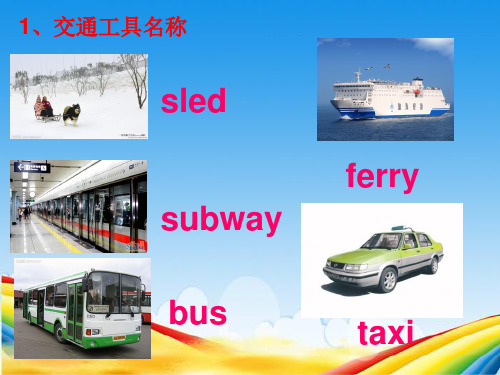
A. to C. a
B. / D. at
11. We go to Beijing ______ train.
A. in
B. at
C. by
12. How do you get to the USA ____China?
A. for
B. to
C. from
13. In the USA, people on bikes must ____ a helmet.
(.) _T_h_e_y_a_r_e__fr_o_m__m__y_c_o_u_s_i_n_i_n_t_h_e__U_S_A_._ 8. get, the, can, I, to, hospital, how
_H_o__w_c_a_n__I_g_e_t_t_o_t_h_e_h_o__s_p_it_a_l?_______
2. That’s good_________ A. exercise. B.a exercise C.the exercise D.excercises
3. What’s this? ________a helmet.
A. This is B. That is C. It’s D Its 4. The bus is__________.
1、交通工具名称
sled
subway
ferry
bus
taxi
2、频率副词
always > usually > often > sometimes > never
3、短语
慢下来:
slow down
注意:
pay attention to
交通信号灯:
traffic lights
Stop and wait at a red light .
(完整版)PEP六年级上册英语第2单元知识点

Unit2: Ways to go to school一、重点单词和短语1. 四会词汇:on foot步行=walk by bus =take a/the bus 乘公交车by plane,乘飞机by taxi 乘出租车by ship乘船by subway 乘地铁by train乘火车by bike骑自行车slow down 慢下来stop 停止wait等go走了解:by…= take a / the …例如:by bus = take a / the bus2. 频率副词:(次数从多到少)always总是> usually通常> often 经常> sometimes有时> never从不3. 其他:pay attention to注意by ferry乘轮渡by sled滑雪橇cross the road横穿马路traffic light(s) 通信号灯at home在家missed(miss的过去式)想念different不同的same 相同的cross穿过look right向右看chopsticks筷子(复数)door门look at朝……看play with和……一起玩二、按要求写单词:go (反义词)come foot(复数)feet child(复数)childrengood(反义词)bad坏的take带走(反义词)bring拿来slow慢的(反义词)quick/fast go(过去式)went do(过去式)did do(第三人称单数)doesgo(第三人称单数)goes same 相同的(反义词)different不同的miss(过去式)missed wrong 错误(反义词)right正确can(否定形式)can’t early早的(反义词)late晚的三、重点句子(一)四会句子1. --- How do you come to school? 你(们)怎么来学校的?--- Usually, I come on foot. = Usually, I walk. 通常情况下,我步行来。
PEP六年级上册英语第2单元知识点

Unit2:Waystogotoschool一、重点单词和短语1.四会词汇:onfoot步行=walk bybus=takea/thebus乘公交车byplane,乘飞机bytaxi乘出租车byship乘船bysubway乘地铁bytrain乘火车slowdown慢下来stop停止wait等了解:by⋯=takea/the⋯例如:bybus=takea/thebusbybikego走骑自行车2.频率副词:(次数从多到少)always总是>usually通常>often经常>sometimes有时>never从不3.其他:payattentionto注意byferry乘轮渡bysled滑雪橇crosstheroad横穿马路trafficlight(s)通信号灯athome在家missed(miss的过去式)想念different不同的same相同的cross穿过lookright向右看chopsticks筷子(复数)door门lookat朝⋯⋯看playwith和⋯⋯一起玩二、按要求写单词:go(反义词)come foot(复数)feet child(复数)childrengood(反义词)bad坏的take带走(反义词)bring拿来slow慢的(反义词)quick/fast go(过去式)went do(过去式)did do(第三人称单数)doesgo(第三人称单数)goes same相同的(反义词)different不同的miss(过去式)missed wrong错误(反义词)right正确can(否定形式)can’t early早的(反义词)late晚的三、重点句子(一)四会句子1.---Howdoyoucometoschool?你(们)怎么来学校的?---Usually,Icomeonfoot.=Usually,Iwalk.通常情况下,我步行来。
2.IntheUSApeopleonbikesmustwearone.在美国骑自行车的人必须带头盔。
新人教(PEP)六年级英语上册Unit 2 Ways to go to school知识点详解

新人教(PEP)六年级英语上册Unit2 知识详解A Let’s talk 知识详解重难点1. 如何询问对方的出行方式—How do you come (to) ...?课文应用:How do you come to school? 你们怎么来学校的?句型结构:How do you come (to) + 地点?重点解析:how: 意为“怎样”,用来询问做事情的方式,位于句首,引导特殊疑问句。
do: 助动词,帮助构成疑问句,无实际意义。
come(to) + 地点:如果come后面所接的词为副词,则要省略介词to,如come here(来这儿)。
生活实例:大熊貓Tuantuan来到了北京,它是怎么来的呢?让我们来看一看吧!How do you come here? 你怎么来这儿的?By plane. 乘飞机。
知识拓展:怎样询问他人的出行方式How does he/she come (to) + 地点?例如:How does she come to the park? 她怎么来公园的?How do they come (to) + 地点?例如:How do they come to the bus station? 他们怎么来公共汽车站的?知识链接:含有how的特殊疑问句小结2. 频度副词大家庭课文应用:Usually, I come on foot. 通常,我走路来。
如果朋友问你“你多久出去旅游一次?”,你要怎么回答呢?答案可以有很多种:一个月一次、经常旅游有时旅游等。
这就需要用到频度副词,如always总是,usually通常,often经常,sometimes有时,never从不等。
语法小贴士:频度副词简介在本课中出现了副词家族中的一个很常见的成员——频度副词。
频度副词又称频率副词,用来表示事情发生的频率,即某事多长时间发生一次。
A Let’s talk知识详解拓展点1. Mrs的用法课文应用:Good morning, Mrs Smith! 早上好,史密斯老师!Mrs是对已婚妇女的称呼,意为“太太;夫人”,用于已婚女子的夫姓前。
六年级PEP英语上册Unit2Waystogotoschool的知识点
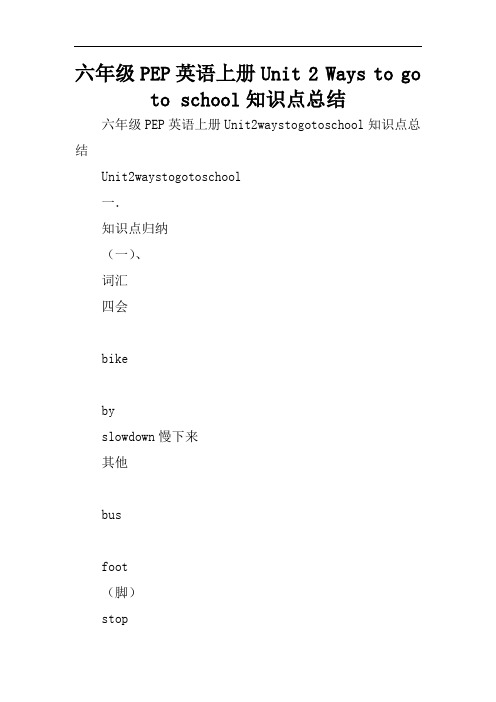
六年级PEP英语上册Unit 2 Ways to go to school知识点总结六年级PEP英语上册Unit2waystogotoschool知识点总结Unit2waystogotoschool一.知识点归纳(一)、词汇四会bikebyslowdown慢下来其他busfoot(脚)stop停下来交通工具traffictoolstrainhow(怎样)planegotoschool(上学)shiptaxi出租车ferry轮渡sled雪橇subway(交通工具前加by,表示乘坐,但步行要用onfoot)(二)、重点句型①询问交通方式用疑问代词how n——Howdoyougo/cometoschool?你怎样去/来上学?——Igo/cometoschoolonfoot. 我走路去/来上学。
n——Howdoes yourfathergotowork?你父亲怎样去上班?——Hegoestoworkbysubway.他坐地铁去上班。
②询问地点,用疑问代词where whereisyourhome?你家在哪里?It’s nearthepostoffice.在邮局旁边。
wherearetheteachers?老师们在哪儿Theyareintheteacher’soffice.在老师的办公室。
③问路:HowcanIgettotheFuxingHospital?我怎么去福星医院?youcantaketheNo.1bus.你可以乘坐1路公交车。
④交通规则:Stopandwaitataredlight.红灯停Goatagreenlight.绿灯行Slowdownandstop atayellowlight.黄灯停⑤youmustdriveslowly. youmustwearalifejacket. youmuststopataredlight你必须开慢点。
你必须穿救生衣。
你必须在红灯时停。
Don’tgoataredlight.Don’trunontheferry.Don’tletthedogsruntoofast. 不要在红灯时走。
PEP六年级上册英语第2单元知识点

Unit2: Ways to go to school一、重点单词和短语1. 四会词汇:on foot步行=walk by bus =take a/the bus 乘公交车by plane,乘飞机by taxi 乘出租车by ship乘船by subway 乘地铁by train乘火车by bike骑自行车slow down 慢下来stop 停止wait等go走了解:by…= take a / the …例如:by bus = take a / the bus\2. 频率副词:(次数从多到少)always总是> usually通常> often 经常> sometimes有时> never从不3. 其他:pay attention to注意by ferry乘轮渡by sled滑雪橇cross the road横穿马路traffic light(s) 通信号灯at home在家missed(miss的过去式)想念different不同的same 相同的cross穿过look right向右看chopsticks筷子(复数)door门look at朝……看play with和……一起玩】二、按要求写单词:go (反义词)come foot(复数)feet child(复数)children good(反义词)bad坏的take带走(反义词)bring拿来slow慢的(反义词)quick/fast go(过去式)went do(过去式)did do(第三人称单数)does go(第三人称单数)goes same 相同的(反义词)different不同的miss(过去式)missedwrong 错误(反义词)right正确can(否定形式)can’t early早的(反义词)late晚的—三、重点句子(一)四会句子1. --- How do you come to school 你(们)怎么来学校的--- Usually, I come on foot. = Usually, I walk. 通常情况下,我步行来。
六年级上册英语素材知识点归纳Unit2_人教PEP
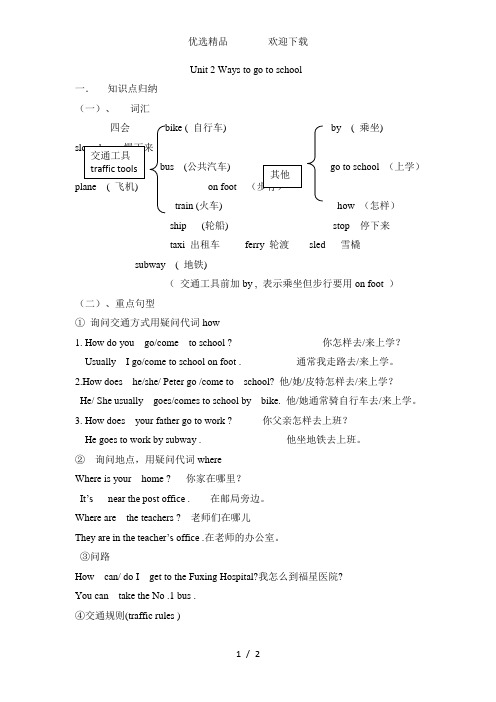
Unit 2 Ways to go to school 一.知识点归纳(一)、词汇四会自行车)by ( 乘坐)慢下来bus (公共汽车) go to school (上学)plane ( 飞机) on foottrain (火车) how (怎样)ship (轮船) stop 停下来taxi 出租车ferry 轮渡sled 雪橇subway ( 地铁)(交通工具前加by , 表示乘坐但步行要用on foot )(二)、重点句型①询问交通方式用疑问代词how1. How do you go/come to school ? 你怎样去/来上学?Usually I go/come to school on foot . 通常我走路去/来上学。
2.How does he/she/ Peter go /come to school? 他/她/皮特怎样去/来上学?He/ She usually goes/comes to school by bike. 他/她通常骑自行车去/来上学。
3. How does your father go to work ? 你父亲怎样去上班?He goes to work by subway . 他坐地铁去上班。
②询问地点,用疑问代词whereWhere is your home ? 你家在哪里?It’s near the post office . 在邮局旁边。
Where are the teachers ? 老师们在哪儿They are in the teacher’s office .在老师的办公室。
③问路How can/ do I get to the Fuxing Hospital?我怎么到福星医院?You can take the No .1 bus .④交通规则(traffic rules )Slow down and stop at a yellow light 黄灯面前要减速并停下来Stop and wait at a red light. 红灯面前停下来并等待Go at a green light. 绿灯行.课本第16面的一些交通规则In China and the USA drivers drive on the right side of the road .在中国和美国,司机靠右行驶。
人教PEP版六年级英语上册Unit 2 知识点清单
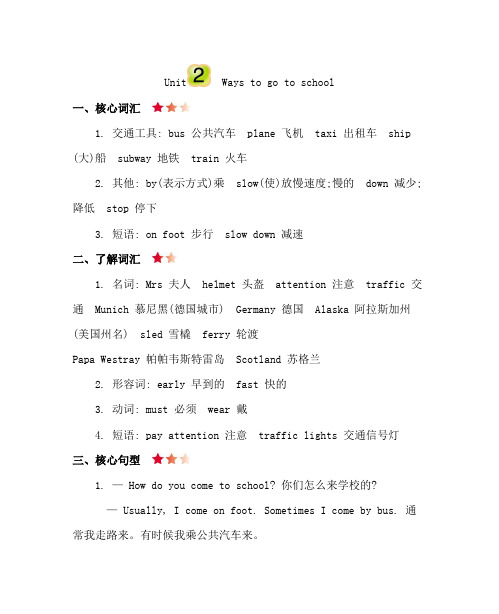
Unit Ways to go to school一、核心词汇1. 交通工具: bus 公共汽车plane 飞机taxi 出租车ship (大)船subway 地铁train 火车2. 其他: by(表示方式)乘slow(使)放慢速度;慢的down 减少;降低stop 停下3. 短语: on foot 步行slow down 减速二、了解词汇1. 名词: Mrs 夫人helmet 头盔attention 注意traffic 交通Munich 慕尼黑(德国城市) Germany 德国Alaska 阿拉斯加州(美国州名) sled 雪橇ferry 轮渡Papa Westray 帕帕韦斯特雷岛Scotland 苏格兰2. 形容词: early 早到的fast 快的3. 动词: must 必须wear 戴4. 短语: pay attention 注意traffic lights 交通信号灯三、核心句型1. — How do you come to school? 你们怎么来学校的?— Usually, I come on foot. Sometimes I come by bus. 通常我走路来。
有时候我乘公共汽车来。
句型结构: — How do/does+主语+go/come (to) …?……怎么去/来……?—主语+go/goes/come/comes ………去/来……(1)助动词do和does要根据主语而进行变化。
当主语是第三人称单数形式的时候要用does,其他则用do。
举一反三: — How do you go to work? 你怎么去上班?— I go to work on foot.我走路去上班。
(2)go home/go there等词组中没有to,因为home/there在这里是副词。
举一反三: — How do you go home?你怎么回家?— How does he go there?他怎么来这里?2. — Mr Jones, how can I get to the Fuxing Hospital? 琼斯先生,我怎么到复兴医院?— Take the No.57 bus over there. 乘那边的57路公共汽车。
pep小学英语六年级上册第一二单元知识点
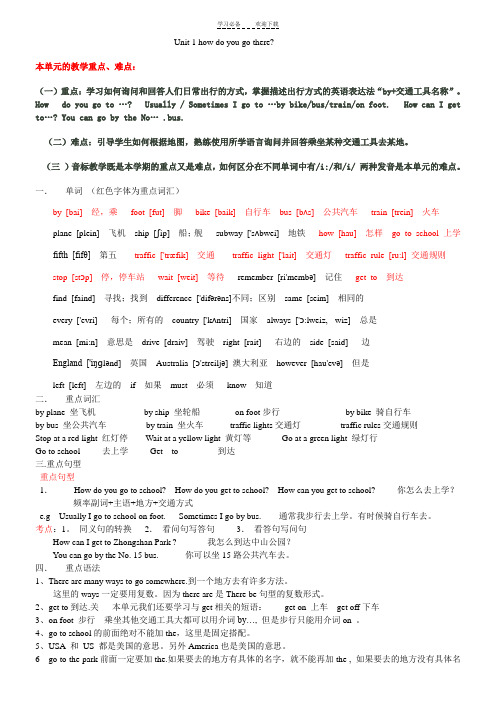
Unit 1 how do you go there?本单元的教学重点、难点:(一)重点:学习如何询问和回答人们日常出行的方式,掌握描述出行方式的英语表达法“by+交通工具名称”。
How do you go to …? Usually / Sometimes I go to …by bike/bus/train/on foot. How can I get to…? You can go by the No… .bus.(二)难点:引导学生如何根据地图,熟练使用所学语言询问并回答乘坐某种交通工具去某地。
(三)音标教学既是本学期的重点又是难点,如何区分在不同单词中有/i:/和/i/ 两种发音是本单元的难点。
一.单词(红色字体为重点词汇)by [bai] 经,乘foot [fut] 脚bike [baik] 自行车bus [bʌs] 公共汽车train [trein] 火车plane [plein] 飞机ship [ʃip] 船;舰subway ['sʌbwei] 地铁how [hau] 怎样go to school 上学fifth [fifθ] 第五traffic ['træfik] 交通traffic light ['lait] 交通灯traffic rule [ru:l] 交通规则stop [stɔp] 停,停车站wait [weit] 等待remember [ri'membə] 记住get to 到达find [faind] 寻找;找到difference ['difərəns]不同;区别same [seim] 相同的every ['evri] 每个;所有的country ['kʌntri] 国家always ['ɔ:lweiz, -wiz] 总是mean [mi:n] 意思是drive [draiv] 驾驶right [rait] 右边的side [said] 边England ['iŋɡlənd] 英国Australia [ɔ'streiljə] 澳大利亚however [hau'evə] 但是left [left] 左边的if 如果must 必须know 知道二.重点词汇by plane 坐飞机by ship 坐轮船on foot步行by bike 骑自行车by bus 坐公共汽车by train 坐火车traffic lights交通灯traffic rules交通规则Stop at a red light 红灯停Wait at a yellow light 黄灯等Go at a green light 绿灯行Go to school 去上学Get to 到达三.重点句型重点句型1.----- How do you go to school? How do you get to school? How can you get to school? 你怎么去上学?---- 频率副词+主语+地方+交通方式e.g Usually I go to school on foot. Sometimes I go by bus. 通常我步行去上学。
pep人教版六年级英语上册Unit2重点知识点综合作文
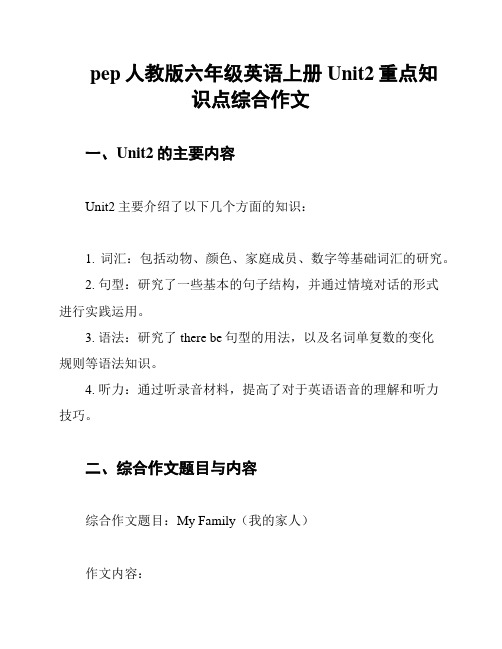
pep人教版六年级英语上册Unit2重点知
识点综合作文
一、Unit2的主要内容
Unit2主要介绍了以下几个方面的知识:
1. 词汇:包括动物、颜色、家庭成员、数字等基础词汇的研究。
2. 句型:研究了一些基本的句子结构,并通过情境对话的形式
进行实践运用。
3. 语法:研究了there be句型的用法,以及名词单复数的变化
规则等语法知识。
4. 听力:通过听录音材料,提高了对于英语语音的理解和听力
技巧。
二、综合作文题目与内容
综合作文题目:My Family(我的家人)
作文内容:
我有一个幸福美满的家庭。
我家有爸爸、妈妈和我。
爸爸和妈妈都是医生,他们非常聪明和勤劳。
爸爸很高,妈妈很漂亮,他们非常爱我,也很疼爱我。
我有一个叫Tom的哥哥,他是大我两岁。
Tom非常友好和懂事,我常常向他请教研究上的问题。
他对我非常关心,有时还给我讲一些有趣的故事。
我家还有两只宠物,一只叫Coco的小狗和一只叫Lucky的小猫。
它们非常可爱和活泼,是我们家的快乐源泉。
我们一家人经常在晚饭时聚在一起,分享一天的收获和快乐。
我们会互相帮助,共同度过每一个美好的日子。
这就是我的家庭,我非常爱我的家人,我相信有一个幸福的家庭会让我更加快乐和自信。
三、总结
通过本单元的研究,我们掌握了一些基础的词汇和句型,同时也了解了家庭的重要性。
希望我们在今后的研究中能够更加努力,不断提高自己的英语能力。
(以上为参考内容,可根据实际情况进行修改和补充)。
PEP六年级英语上册第二单元知识点
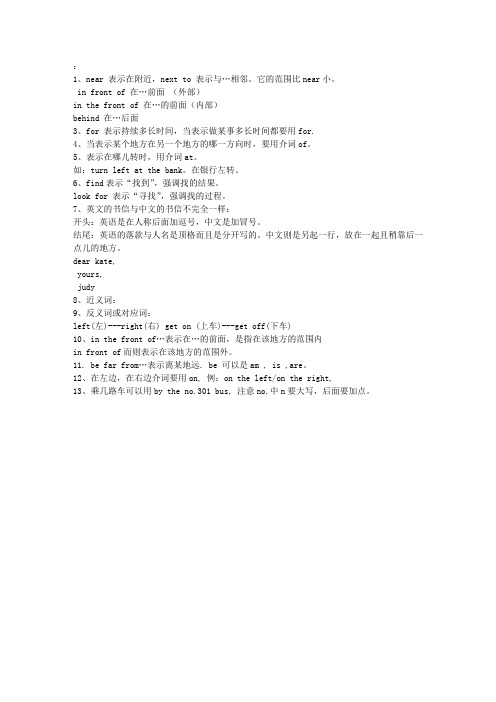
:
1、near 表示在附近,next to 表示与…相邻。
它的范围比near小。
in front of 在…前面(外部)
in the front of 在…的前面(内部)
behind 在…后面
3、for 表示持续多长时间,当表示做某事多长时间都要用for.
4、当表示某个地方在另一个地方的哪一方向时,要用介词of。
5、表示在哪儿转时,用介词at。
如:turn left at the bank。
在银行左转。
6、find表示“找到”,强调找的结果。
look for 表示“寻找”,强调找的过程。
7、英文的书信与中文的书信不完全一样:
开头:英语是在人称后面加逗号,中文是加冒号。
结尾:英语的落款与人名是顶格而且是分开写的。
中文则是另起一行,放在一起且稍靠后一点儿的地方。
dear kate,
yours,
judy
8、近义词:
9、反义词或对应词:
left(左)---right(右) get on (上车)---get off(下车)
10、in the front of…表示在…的前面,是指在该地方的范围内
in front of而则表示在该地方的范围外。
11. be far from…表示离某地远. be 可以是am , is ,are。
12、在左边,在右边介词要用on, 例:on the left/on the right,
13、乘几路车可以用by the no.301 bus, 注意no.中n要大写,后面要加点。
人教版(PEP)小学英语六年级上册各单元知识点归纳(三年级起点)
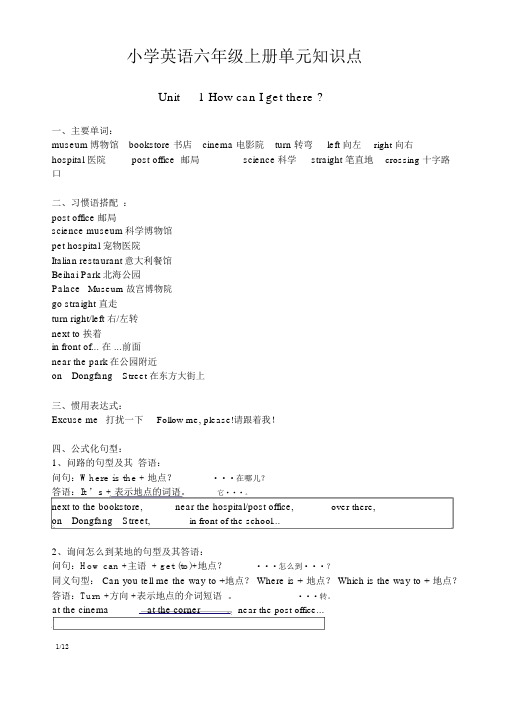
小学英语六年级上册单元知识点Unit 1 How can I get there ?一、主要单词:museum博物馆bookstore 书店cinema 电影院turn 转弯left 向左right 向右hospital 医院post office 邮局science科学straight 笔直地crossing 十字路口二、习惯语搭配:post office 邮局science museum科学博物馆pet hospital 宠物医院Italian restaurant意大利餐馆Beihai Park 北海公园Palace Museum 故宫博物院go straight 直走turn right/left 右/左转next to 挨着in front of... 在 ...前面near the park在公园附近on Dongfang Street 在东方大街上三、惯用表达式:Excuse me打扰一下Follow me, please!请跟着我!四、公式化句型:1、问路的句型及其答语:问句:Where is the + 地点?···在哪儿?答语:It ’s + 表示地点的词语。
它···。
next to the bookstore,near the hospital/post office,over there,on Dongfang Street,in front of the school...2、询问怎么到某地的句型及其答语:问句:How can +主语 + get (to)+地点?···怎么到···?同义句型: Can you tell me the way to +地点? Where is + 地点? Which is the way to + 地点?答语:Turn +方向 +表示地点的介词短语。
PEP人教版六年级英语上册期末知识点分类复习与检测-Unit2(含答案及听力材料)
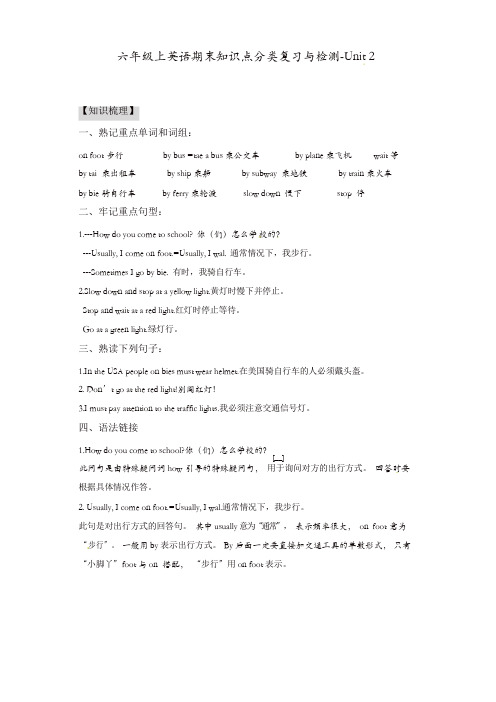
六年级上英语期末知识点分类复习与检测-Unit2【知识梳理】一、熟记重点单词和词组:on foot步行by bus=tae a bus乘公交车by plane乘飞机wait等by tai乘出租车by ship乘船by subway乘地铁by train乘火车by bie骑自行车by ferry乘轮渡slow down慢下stop停二、牢记重点句型:1.---How do you come to school?你(们)怎么学校的?---Usually,I come on foot.=Usually,I wal.通常情况下,我步行。
---Sometimes I go by bie.有时,我骑自行车。
2.Slow down and stop at a yellow light.黄灯时慢下并停止。
Stop and wait at a red light.红灯时停止等待。
Go at a green light.绿灯行。
三、熟读下列句子:1.In the USA people on bies must wear helmet.在美国骑自行车的人必须戴头盔。
2.Don’t go at the red light!别闯红灯!3.I must pay attention to the traffic lights.我必须注意交通信号灯。
四、语法链接1.How do you come to school?你(们)怎么学校的?[__]此问句是由特殊疑问词how引导的特殊疑问句,用于询问对方的出行方式。
回答时要根据具体情况作答。
ually,I come on foot.=Usually,I wal.通常情况下,我步行。
此句是对出行方式的回答句。
其中usually意为“通常”,表示频率很大,on foot意为“步行”。
一般用by表示出行方式。
By后面一定要直接加交通工具的单数形式,只有“小脚丫”foot与on搭配,“步行”用on foot表示。
最新人教pep版小学英语毕业课本知识点单元复习第20课时六年级上册 Unit 2
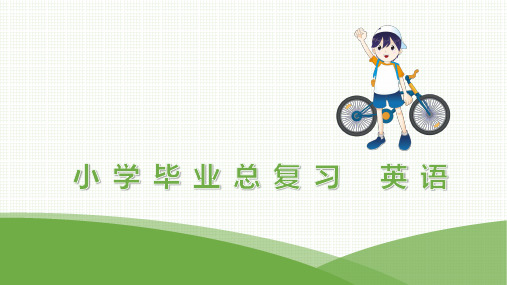
know them well and follow them. They will keep you safe (安全的).
There are three kinds of traffic signs: the prohibition (禁令) sign, the
direction (指示) sign and the warning (警告) sign. The first one is about
what is
返回目录
forbidden (禁止的). The second one is about where you are now and where you should go. The last (最后的) one is about some important (重要的) things you should pay attention to.
6.____o_n_____ the 7.___r_i_g_h_t___ side of the road in Guangzhou. In
Hong Kong, we 8.___m__u_st_n_'_t_ drive on the right side of the road. We
must drive on the 9._____le_f_t___ side of the road. You can go if the
John: 4.___I_c_o_m__e_t_o_s_c_h_o_o_l_b_y__s_u_b_w_a_y_._________ My home is near
the subway station (地铁站).
Miss White: It's fast,too. Chen Jie, what about you?
- 1、下载文档前请自行甄别文档内容的完整性,平台不提供额外的编辑、内容补充、找答案等附加服务。
- 2、"仅部分预览"的文档,不可在线预览部分如存在完整性等问题,可反馈申请退款(可完整预览的文档不适用该条件!)。
- 3、如文档侵犯您的权益,请联系客服反馈,我们会尽快为您处理(人工客服工作时间:9:00-18:30)。
Unit2: Ways to go to school
一、重点单词和短语
1. 四会词汇:
on foot步行=walk by bus =take a/the bus 乘公交车by plane,乘飞机by taxi 乘出租车by ship乘船by subway 乘地铁by train乘火车by bike骑自行车slow down 慢下来stop 停止wait等go走
了解:by…= take a / the …例如:by bus = take a / the bus
2. 频率副词:(次数从多到少)
always总是> usually通常> often 经常> sometimes有时> never从不
3. 其他:
pay attention to注意by ferry乘轮渡by sled滑雪橇
cross the road横穿马路traffic light(s) 通信号灯at home在家
missed(miss的过去式)想念different不同的same 相同的
cross穿过look right向右看chopsticks筷子(复数)door门look at朝……看play with和……一起玩二、按要求写单词:
go (反义词)come foot(复数)feet child(复数)children
good(反义词)bad坏的take带走(反义词)bring拿来slow慢的(反义词)quick/fast go(过去式)went do(过去式)did do(第三人称单数)does
go(第三人称单数)goes same 相同的(反义词)different不同的miss(过去式)missed wrong 错误(反义词)right正确can(否定形式)can’t early早的(反义词)late晚的三、重点句子
(一)四会句子
1. --- How do you come to school? 你(们)怎么来学校的?
--- Usually, I come on foot. = Usually, I walk. 通常情况下,我步行来。
2. In the USA people on bikes must wear one. 在美国骑自行车的人必须带头盔。
3. Don’t go at the red light! 别闯红灯!
4. I must pay attention to the traffic lights. 我必须注意交通信号灯。
四、重点语法
1. How do you come to school? 你(们)怎么来学校的?
此问句是由特殊疑问词how引导的特殊疑问句,用于询问对方的出行方式。
回答时要根据具体情况作答。
表示地点的词:
Germany德国Munich慕尼黑England英国Australia澳大利亚
school学校the park 公园the cinema电影院the hospital医院
the post office邮局the bus stop公共汽车站home家
2. Usually, I come on foot. = Usually, I walk. 通常情况下,我步行来。
此句是对出行方式的回答句。
其中usually意为“通常”,表示频率很大,on foot意为“步行”。
一般用by表示出行方式。
by后面一定要直接加交通工具的单数形式,只有“小脚丫”foot与on 搭配,“步行”用on foot表示。
练习:I usually come to school on foot.(对划线部分提问)
________________________________________________
3. I must pay attention to the traffic lights. 我必须注意交通信号灯。
must是情态动词,意为“必须”后面跟动词原形。
动作词组:
wear a helmet戴头盔pay attention to the traffic lights注意交通信号灯
look right向右看wear a life jacket 穿救生衣
4. Don’t go at the red light! 别闯红灯!
此句是Don’t开头的祈使句的否定句,don’t后面跟动词原形。
意为“不要做某事”。
动作词组:run跑go at the red light闯红灯touch the door触摸门
Eg. Don’t smoke.不要吸烟。
/ 禁止吸烟。
Don’t take photos.禁止拍照。
注意:祈使句的否定句变为肯定句就是把Don’t去掉,句首字母改为大写。
5. We must look right before crossing the road.我们在横穿马路前必须看看右边。
此句中must是情态动词,意为“必须”后面跟动词原形,在此句中before是一个介词,而
介词后面跟动词-ing形式。
6. There is no door on the bus.公共汽车上没有门。
此句是there be句型的单数句,be动词要根据后面名词的单复数形式来决定,名词为单数或不可数名词就用there is, 名词为复数就用there are. 此句中no door意为“没有门”,表示单数含义,因此要用there is开头。
注意:there be句型的否定句和一般疑问句的变换方法以及回答。
原句:肯定句:There are some books on the desk.
否定句:There are not / aren’t _______ books on the desk.
一般疑问句:Are there any books on the desk?
Yes, ___________.
No, ____________.
五、句型变换:
1. You must stop at the red light. (改为祈使句)
____________________________________
2. Go at the red light. (改为否定句)
_______ go at the red light.
3. Don’t stop at the red light. (改为肯定句)
____________________________________
4. I come to school by bus. (对划线部分提问)
________ do _______ come to school?
5. I come to school on foot. (写出同义句)
I ________ to school.
六、完成下列对话.
A: _______ ______ . _______ _____a post office near here?
B: Yes, ________ ________. It’s ________ to the bank.
A: _____ ________ ________ ?
B: No, it’s near here.
A: _____ ______ ________ __________ _________ ?
B: You can go by the No. 12 bus. _______ ________ the bus at the park.
Then get off at the zoo. Walk ____________ for two minutes. It’s _____ the left.
A: _____________ .
B: You’re welcome.
七、根据对话中上下文意思,在空格中填上合适的词使句子完整。
1 _ can I go to the zoo ? You can go the No.41 bus.
2. _ is the science museum? It’s ______the bank.
3. I want to buy a book, I’m going to the . I want to send a letter. I’m going to the .
4. If you hurt your leg. You can go to the to see a .
5. A is a place where you can get or save money.。
